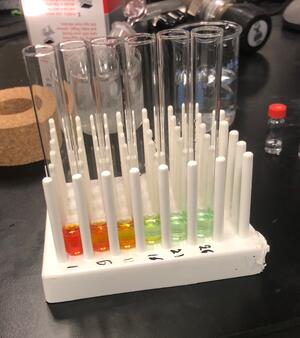By Alayna Johnson, 2019-2020 SCS Student Advising Leader
As an SCS advising ambassador, one of my jobs is to attend information sessions for prospective and admitted chemistry/chemical engineering students. One of the most commonly asked questions is the difference between the 100-level general chemistry sequence (102-105) and the 200-level general chemistry sequence (202-204). Both cover roughly the same material, but some major differences do exist. Here are some of the factors you may consider when deciding between these two tracks:
Major: Most, if not all, chemistry science and letters and CS+CHEM students opt to take the 100-level sequence because it satisfies their degree requirements and gives them more flexibility to take other courses. Specialized chemistry and chemical engineering students, on the other hand, take either the 100-level or the 200-level sequence. Those who take the 100-level sequence must take a 4-credit hour bridge sequence (CHEM 222 and 223). However, this path ends up being a great choice for some students because of the difficulty of the 200-level courses.
Transfer credit: Some students come in with AP, IB, or transfer credit in general chemistry. These credits, especially AP and IB, can usually only be applied to the 100-level sequence. If you are a Specialized Chemistry or Chemical Engineering student who wishes to take the 200-level sequence, you will likely have to forfeit your chemistry transfer credits. Also, keep in mind that no AP credit is awarded for laboratory courses at any level.
Prior experience: While both the 100-level and 200-level courses cover similar material, the 200-level sequence tends to go more in-depth. In my experience, the 200-level courses require not only basic math and chemistry skills, but also strong chemical intuition, problem-solving, and memorization skills. Thus, it may help to have prior chemistry experience if you decide to take the 200-level courses.
Laboratory skills: Most people agree that the biggest difference between the 100-level and 200-level classes are the laboratory portions (103/105 and 203/205). The 100-level labs are focused on reinforcing the concepts learned in lecture and refining practical skills (including measuring, pipetting, titrating, and data analysis) while the 200-level sequence dives head-first into advanced techniques to prepare students for successful careers as research chemists and chemical engineers. The 200-level courses include weekly, professional-quality lab reports including the infamous cations and cobalt reports. Professor Ray, who teaches general chemistry here at Illinois, likes to joke that some CHEM 105 lab reports take 15 minutes while some CHEM 205 lab reports take 15 hours! That said if you do decide to take the 200-level courses, opt for a slightly easier schedule and leave plenty of time for studying and writing reports. If you’re ready for the challenge, check out my four biggest tips for excelling in CHEM 203 and 205.
Cohort: I’ve named several “cons” in taking the 200-level sequence, but I also wanted to share the “pros” and what I loved about taking CHEM 202-205. The biggest pro, by far, is that the accelerated sequence surrounds you with peers in your major who are as passionate about science as you are! (One of my best friends on campus is the person I sat next to on the first day of CHEM 202 lecture) You’ll also get the opportunity to bond with your fellow students, TAs, and professors during both the fun times and the times that are difficult (again, I’m looking at you, cobalt lab). You’ll be placed in small discussions and be exposed to cutting-edge chemistry as a freshman.
As always, contact your SCS academic advisor with any questions or concerns before making a final decision.
